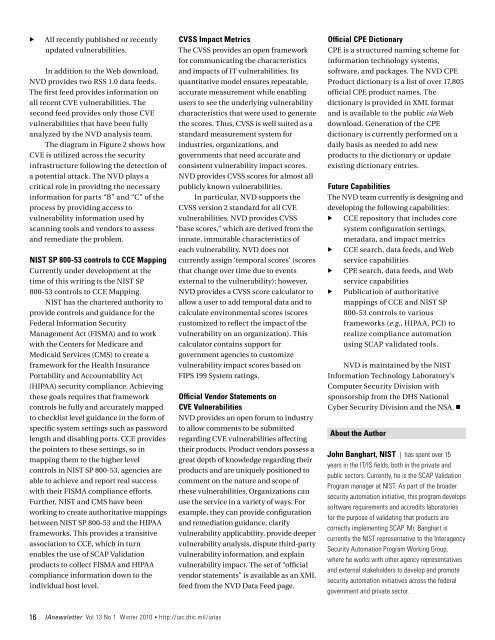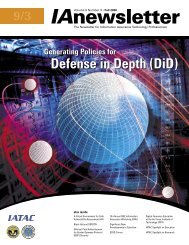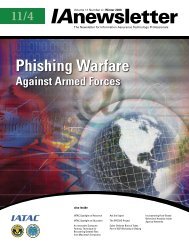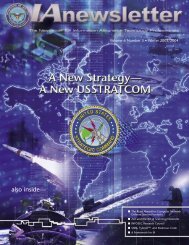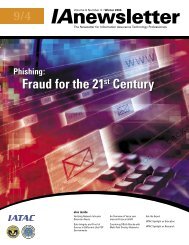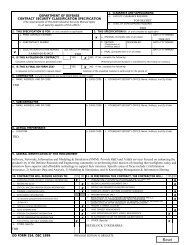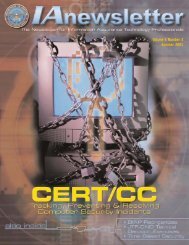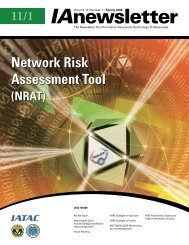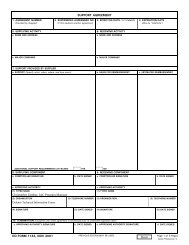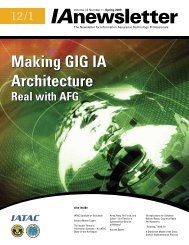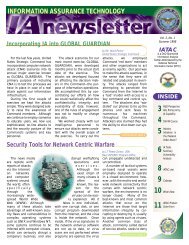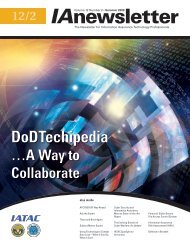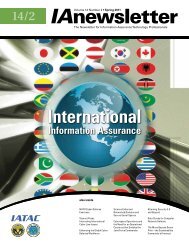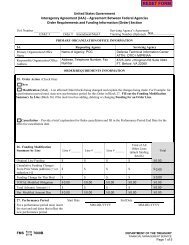Security Automation - IAC - Defense Technical Information Center
Security Automation - IAC - Defense Technical Information Center
Security Automation - IAC - Defense Technical Information Center
You also want an ePaper? Increase the reach of your titles
YUMPU automatically turns print PDFs into web optimized ePapers that Google loves.
ff<br />
All recently published or recently<br />
updated vulnerabilities.<br />
In addition to the Web download,<br />
NVD provides two RSS 1.0 data feeds.<br />
The first feed provides information on<br />
all recent CVE vulnerabilities. The<br />
second feed provides only those CVE<br />
vulnerabilities that have been fully<br />
analyzed by the NVD analysis team.<br />
The diagram in Figure 2 shows how<br />
CVE is utilized across the security<br />
infrastructure following the detection of<br />
a potential attack. The NVD plays a<br />
critical role in providing the necessary<br />
information for parts “B” and “C” of the<br />
process by providing access to<br />
vulnerability information used by<br />
scanning tools and vendors to assess<br />
and remediate the problem.<br />
NIST SP 800-53 controls to CCE Mapping<br />
Currently under development at the<br />
time of this writing is the NIST SP<br />
800-53 controls to CCE Mapping.<br />
NIST has the chartered authority to<br />
provide controls and guidance for the<br />
Federal <strong>Information</strong> <strong>Security</strong><br />
Management Act (FISMA) and to work<br />
with the <strong>Center</strong>s for Medicare and<br />
Medicaid Services (CMS) to create a<br />
framework for the Health Insurance<br />
Portability and Accountability Act<br />
(HIPAA) security compliance. Achieving<br />
these goals requires that framework<br />
controls be fully and accurately mapped<br />
to checklist level guidance in the form of<br />
specific system settings such as password<br />
length and disabling ports. CCE provides<br />
the pointers to these settings, so in<br />
mapping them to the higher level<br />
controls in NIST SP 800-53, agencies are<br />
able to achieve and report real success<br />
with their FISMA compliance efforts.<br />
Further, NIST and CMS have been<br />
working to create authoritative mappings<br />
between NIST SP 800-53 and the HIPAA<br />
frameworks. This provides a transitive<br />
association to CCE, which in turn<br />
enables the use of SCAP Validation<br />
products to collect FISMA and HIPAA<br />
compliance information down to the<br />
individual host level.<br />
CVSS Impact Metrics<br />
The CVSS provides an open framework<br />
for communicating the characteristics<br />
and impacts of IT vulnerabilities. Its<br />
quantitative model ensures repeatable,<br />
accurate measurement while enabling<br />
users to see the underlying vulnerability<br />
characteristics that were used to generate<br />
the scores. Thus, CVSS is well suited as a<br />
standard measurement system for<br />
industries, organizations, and<br />
governments that need accurate and<br />
consistent vulnerability impact scores.<br />
NVD provides CVSS scores for almost all<br />
publicly known vulnerabilities.<br />
In particular, NVD supports the<br />
CVSS version 2 standard for all CVE<br />
vulnerabilities. NVD provides CVSS<br />
“base scores,” which are derived from the<br />
innate, immutable characteristics of<br />
each vulnerability. NVD does not<br />
currently assign ‘temporal scores’ (scores<br />
that change over time due to events<br />
external to the vulnerability); however,<br />
NVD provides a CVSS score calculator to<br />
allow a user to add temporal data and to<br />
calculate environmental scores (scores<br />
customized to reflect the impact of the<br />
vulnerability on an organization). This<br />
calculator contains support for<br />
government agencies to customize<br />
vulnerability impact scores based on<br />
FIPS 199 System ratings.<br />
Official Vendor Statements on<br />
CVE Vulnerabilities<br />
NVD provides an open forum to industry<br />
to allow comments to be submitted<br />
regarding CVE vulnerabilities affecting<br />
their products. Product vendors possess a<br />
great depth of knowledge regarding their<br />
products and are uniquely positioned to<br />
comment on the nature and scope of<br />
these vulnerabilities. Organizations can<br />
use the service in a variety of ways. For<br />
example, they can provide configuration<br />
and remediation guidance, clarify<br />
vulnerability applicability, provide deeper<br />
vulnerability analysis, dispute third-party<br />
vulnerability information, and explain<br />
vulnerability impact. The set of “official<br />
vendor statements” is available as an XML<br />
feed from the NVD Data Feed page.<br />
Official CPE Dictionary<br />
CPE is a structured naming scheme for<br />
information technology systems,<br />
software, and packages. The NVD CPE<br />
Product dictionary is a list of over 17,805<br />
official CPE product names. The<br />
dictionary is provided in XML format<br />
and is available to the public via Web<br />
download. Generation of the CPE<br />
dictionary is currently performed on a<br />
daily basis as needed to add new<br />
products to the dictionary or update<br />
existing dictionary entries.<br />
Future Capabilities<br />
The NVD team currently is designing and<br />
developing the following capabilities:<br />
ff<br />
ff<br />
ff<br />
ff<br />
CCE repository that includes core<br />
system configuration settings,<br />
metadata, and impact metrics<br />
CCE search, data feeds, and Web<br />
service capabilities<br />
CPE search, data feeds, and Web<br />
service capabilities<br />
Publication of authoritative<br />
mappings of CCE and NIST SP<br />
800-53 controls to various<br />
frameworks (e.g., HIPAA, PCI) to<br />
realize compliance automation<br />
using SCAP validated tools.<br />
NVD is maintained by the NIST<br />
<strong>Information</strong> Technology Laboratory’s<br />
Computer <strong>Security</strong> Division with<br />
sponsorship from the DHS National<br />
Cyber <strong>Security</strong> Division and the NSA. n<br />
About the Author<br />
John Banghart, NIST | has spent over 15<br />
years in the IT/IS fields, both in the private and<br />
public sectors. Currently, he is the SCAP Validation<br />
Program manager at NIST. As part of the broader<br />
security automation initiative, this program develops<br />
software requirements and accredits laboratories<br />
for the purpose of validating that products are<br />
correctly implementing SCAP. Mr. Banghart is<br />
currently the NIST representative to the Interagency<br />
<strong>Security</strong> <strong>Automation</strong> Program Working Group,<br />
where he works with other agency representatives<br />
and external stakeholders to develop and promote<br />
security automation initiatives across the federal<br />
government and private sector.<br />
16 IAnewsletter Vol 13 No 1 Winter 2010 • http://iac.dtic.mil/iatac


